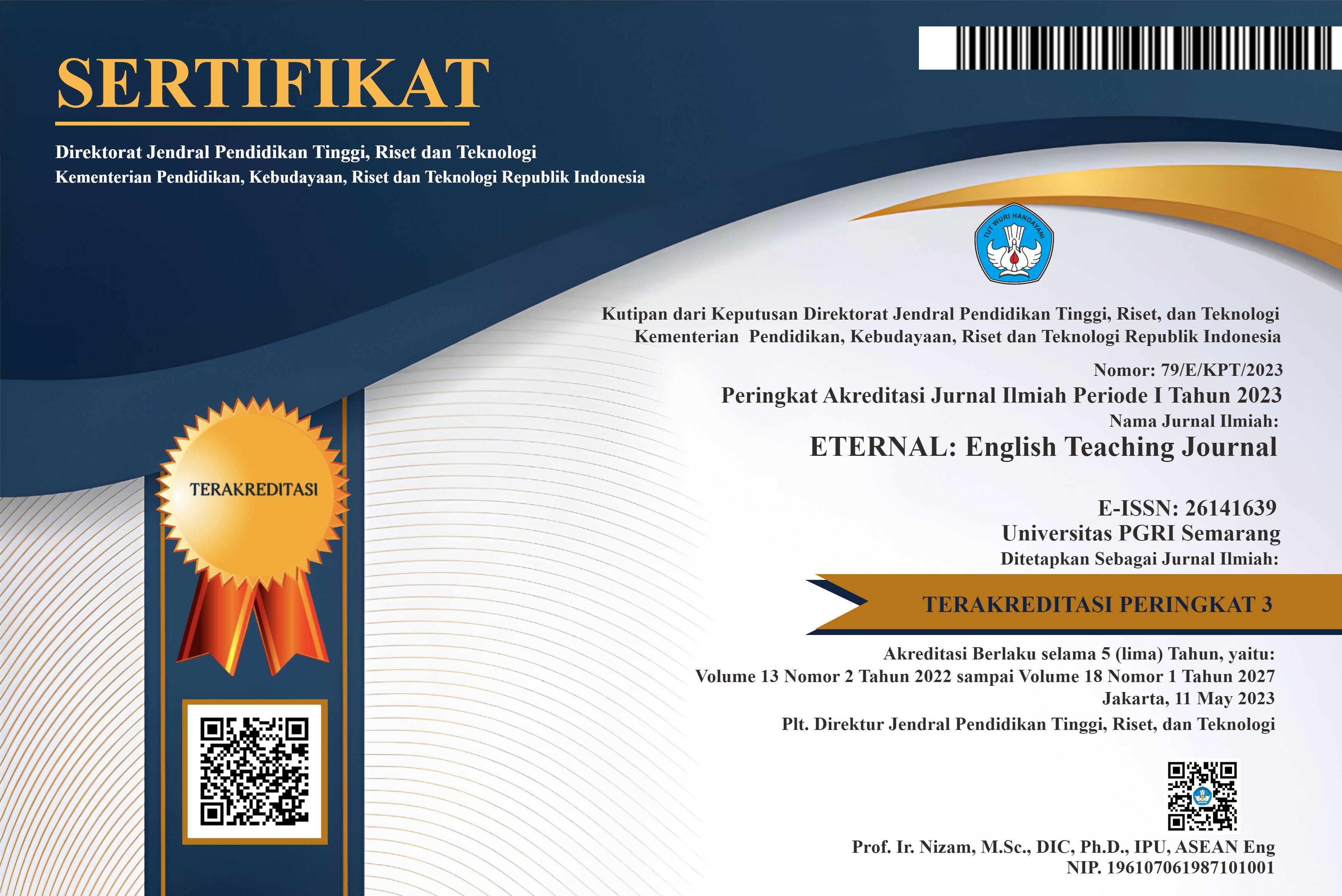Rhetorical Structure of University Promotional Brochures Written by Indonesians at Undergraduate and Graduate Programs
DOI:
https://doi.org/10.26877/eternal.v16i1.1129Keywords:
Rhetorical Structure, brochures, undergraduate, postgraduateAbstract
The purposes of this research were to know the rhetorical structures of university brochures of undergraduate and graduate program and the differences of them in term of moves and steps. This research was qualitative and quantitative in nature; in other words, it employed mixed method. Qualitative data was taken in the forms of university brochures communicative purposes narrations, whereas quantitative data in the form of move and step frequency and percentage. The rhetorical structure are as follows: service Provider Overview, presenting academic service, Internationalism, presenting university achievement, presenting student life, Presenting the location of the service, Validating the effectiveness of service provided, Special notes. From those moves and steps structures, all the moves proposed by Barabas are found where service provider, presenting academic, presenting students life, presenting service location, and special notes are 100% obligatory for undergraduate level; service provider, presenting academic, special notes are 100% obligatory. For steps, university names, university emblems, university departments, academic programs, procedure applications, contact information are 100% obligatory in undergraduate and university names, university emblems, brochure titles, university departments, academic programs are 100% obligatory. The differences between undergraduate and graduate promotional brochures are on the move of validating the effectiveness of service provided, from steps numbers on respective moves, the status obligatory or optional of moves and steps.
References
Alali, B. A., & Ali, A. M., (2019). Genre-based Analysis of travel guide: A study on Malaysia, Thailand and the Philipines. LSP international Journal, Vol.6, issue 2, 2019, pp. 1-21. Https://doi.org/10.11113/lspi.v6n2.86
Assyita, U. H, Purwanti, O., & Anam, S., (2023). A comperative analysis of rhetorical move and genre knowledge development of English and Indonesian Theses. LEEA Journal, Vol.6 no.2, pp.386-396. https://journal.ipm2kpe.or.id/index.php/LEEA/article/view/6082/3879
Barabas,C. D., (2018). Rhetorical Moves and the Functional Constituent of Process in Higher Education Institutions’ Promotional Materials. The Asian ESP Journal. 371-384. https://www.researchgate.net/profile/cris_barabas/publication/
Bhatia, V. K. (2013). Analysing Genre. London and New York. Routledge.
Chaidet, C. (2021). Move analysis of women and men`s personal care product online advertisements. JSEL. Vo.16, no.2. https://so04.tci-thaijo.org/index.php/jsel/article/view/248582/173733
Geburina, M. (2022). Macro and Micro Level Analysis of Indonesian Business E- Mails Written by Minangkabau And Javanese Speakers. Vernacular. Vol.1, No.2, pp. 42-47. https://doi.org/10.35447/vernacular.v1i2.454
Hajimia, H. et al. (2022). Rhetorical structure of newspaper reports: A synergy between corpus, genre and discourse analysis. IJAl. Vol.12, no.1. pp.88-99. https://doi.org/10.17509/ijal.v12i1.46433.
Khan, F, Jhan, D., & Zafar, M., (2022). A ganre based analysis of classified advertisiments in Pakistani English Newspaper. Global Digital & Print Media Review. Pp. 147-157. Doi:10.31703/gdpmr.2022(V-II).14
Kim, J. E., & Uhm, C. J., (2017). Marketization of university brochures in Korea and the US:From a genre Analysis Perpective. Pp.94-99. https://doi.org/10.24303/lakdoi.2017.25.98.
Lestari, V. D, & Kawati, R., (2023). Genre Analysis of online promotion on Nihi Tourism website. Vol. 17, No. 2. PP.195-205. https://journal.trunojoyo.ac.id/prosodi/article/view/20077
Loan, N & Pramoolsook, I., (2015). A move analysis of method chapters by Vietnamese TESOL master`s Students. Research Scholars Journal. Vol. 3, no.1, pp. 14-27. From: www.researchscholar.co.in
Luo, J., & Huang, T., (2015). Genre- based analysis of American Tourism Brochure. Open journal of Social science. Vol. 2, pp.200-208. Http://dx.doi.org/10.4236/jss.2015.39028.
Martono, Nanang. (2010). Metode Penelitian Kuantitatif. Jakarta. Rajawali Press.
Russel, A. (2022). A discourse analysis of fast food advertisements. IJRP Journal. Vol. 111, No. 1. Pp. 300-3017. https://www.researchgate.net/profile/Russel-Aporbo.
Tocalo, A. (2021). Move structures and their rhetorical verbs of research articles abstracts across Englishes. IJAL. Vol.11 no. 1, pp.1-10. Https://doi.org/10.17509/ijal.v1i1.34593
Usman, B., Rizki, I., Samad, I, A., (2019). Hints to mayor Election: genre Analysis of the Political Advertisment on Aminullah-Zainal Poster in Aceh. English Education Journal (EEJ), Vol. 10. No. 2. pp. 129-139. https://jurnal.usk.ac.id/EEJ/article/view/13878/10493
Zhang, T. (2017). The Marketization of Higher education discourse: A genre Analysis of University website homepages in China. Vol. 68 no.1 pp.23-33. http://doi.org/10.5539/hes.v7n3p64. https:files.eric.ed.gov/fulltext/ej1150060.pdf
Swales, J., M. (1990). Genre Analysis. English in academic and research setting. Cambridge University press.
Yongqing, L. (2013). A genre-based analysis of Hotel Advertisement in Malaysia. Master Theses. http://studentsrepo.um.edu.my.
Warsidi, Damayanti, N, & Syurganda, A., (2024). The Rhetorical Study of IELTS Speaking Test Band 7 or Above. Premise Journal. Vol. 13. No.2. pp. 429–446. https://doi.org/10.24127/pj.v13i2.9256
Wijayanti, S., H. (2017). The moves of Indonesian application letter. Lingua Cultura. Vol.11, no.1., pp. 39-45. Doi:10.21512/lc.v11i1.1762







